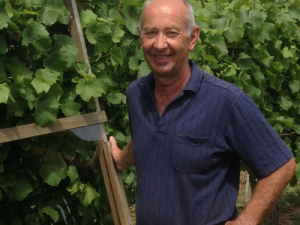From Newcastle-Upon-Tyne to Cardiff, Stanford University, to Canberra and finally New Zealand, his efforts have helped uncover the importance of light UV on fruit. For the past 12 years he has focused that research on wine grapes.
The former Dean of Lincoln University, has been a member of the Board of the Marlborough Wine Research Centre since 2003. In 2008 he “pulled out of management” at Lincoln and with the help of NZ Winegrowers transferred back into his academic professorship to work with the wine industry.
There is probably no better place to be studying the effects of UV-B on grapes than in the Southern Hemisphere, Dr Jordan admits.
“In New Zealand we have about 30 to 40 percent higher UV-B radiation than an equivalent latitude in the northern hemisphere. That is UV in the environment, without anything to do with ozone depletion or anything like that. The natural UV environment is significantly higher.”
UV-B is the radiation that affects all life forms, it is the one that causes sunburn in humans, and as Dr Jordan has discovered it also has a major impact on plant life of all forms.
“UV-B is absorbed by a lot of molecules, it is highly energetic and can do damage. However, recently UV-B has also been shown to have more positive effects on plant growth and development.”
So when a grower removes leaves from a vine to minimize humidity and a subsequent disease threat they open the fruit to UV exposure and this will cause changes to the grape berry biochemistry.
“The one thing UV-B does, is actually increase the flavonoid compounds and that can bring about a change in the antioxidant capability of the berries,” he says.
“The flavonoids are in the skins so they can alter the skin characteristics as well. So once you expose the fruit to extra UV, you are changing the characteristics of the grapes.”
Which could be one reason why certain varieties grown in New Zealand throw up differing characteristics than the same varieties grown in the northern hemisphere.
It is literally another aspect of terroir – where climatic conditions impact on the end wine.
“Absolutely right. The light environment is a major factor. The other component is that UV-B interacts with other environments, such as higher temperatures or water status. All these factors interact to give you the outcome of the grape composition and the uniqueness of an individual region. Even the grape varieties themselves appear to react differently to UV.”
His research has shown that compounds such as methoxypyrazines, or the aroma compounds, can change dramatically.
“The high levels of these are produced just pre veraison. Those levels are then reflected in the grape berries at harvest time and the wine. So leaf removal can reduce these levels, although that is very dependent on the season. The role of light and UV-B remains unclear.”
Dr Jordan says the largest impact on methoxypyrazines tends to be in a cooler season. Which is a catch 22 for growers, who often remove leaves to help the fruit ripen in time, when temperatures are not at their optimum level.
The research has also shown that leaf removal has an effect on the levels of amino acids in berries.
“Leaf removal decreased the amount of amino acids that go into the berry. That is highly significant because amino acids are there for YAN for fermentation and they also add to the quality of the wine. They are the pre-cursors for a lot of different flavour compounds. So if you reduce canopy, you reduce those amino acids.”
The third finding in the research concerns levels of flavonoids and how UV-B impacts on them.
“We have confirmed that UV-B increases the level of these flavonoids, in particular a type called flavonols. These are the compounds which are recognised in the industry as quercetin and kaempferol. These compounds are increased substantially as soon as the fruit is exposed to UV-B and they alter the characteristics of the grape at harvest.”
Which creates a conundrum for growers, he admits. Do you remove leaves to prevent disease pressure at the risk of changing the flavour components of the fruit? Or do you leave the canopy unmanaged and risk disease towards the end of the season? Dr Jordan says the answer may lie in the timing of that leaf removal, which is where his research is heading now.
While this is a full time project, it hasn’t prevented him from spreading his wings into other fields. He is currently editing a book, due to be released late this year, entitled The role of UV-B radiation in plant growth and development.
He has also been granted a prestigious Marsden research grant to investigate the adaptation of plants to the terrestrial environment.
“That is essentially how plants moved from an aquatic environment onto land and dealt with difficult dry and high UV environments. What were the protective compounds produced to allow them to do that.
“So we are looking at primitive biochemical pathways that provided protection to these early land adapters. This all relates back to UV and understanding the various protective compounds produced, which in turn links up to the grape research.”












